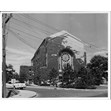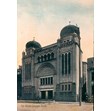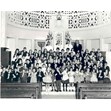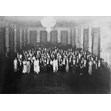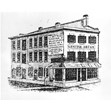- Accession Number
- 2013-7-8
- Source
- Archival Accessions
- Accession Number
- 2013-7-8
- Material Format
- textual record
- moving images
- graphic material
- Physical Description
- 1 folder of textual records
- 1 optical disc (48:20 min.) : col. ; DVD
- 35 photographs : col. ; 16 x 11 cm
- Date
- 2006-2012
- Scope and Content
- Accession consists of records related to the military career of Corporal Tamar Freeman, particularly her 6-month deployment to Kandahar, Afghanistan. Included is postcard and email correspondence sent to her parents detailing issues of camp life, her religious observance, as well as her role as a medic; a DVD of the film "Sisters in Arms" written and directed by Tamar's sister, Beth Freeman; newspaper clippings and articles on Tamar and the film "Sisters in Arms"; photographs of Tamar receiving an award from the Canadian Jewish Congress, of her family greeting her at the airport upon return to Canada, a portrait of Tamar with another soldier and General Hillier, as well as images taken of fellow soldiers and the surroundings while in Afghanistan.
- Administrative History
- Corporal Tamar Freeman (1967-) is the daughter of Harvey and Gilda Freeman. She began her military career as an army reservist in 1990. As a reservist, she committed one day per week and one weekend per month to working in hospitals on board ships and in defence research facilities. In 2006, she joined the regular infantry as a medic in the Second Field Ambulance unit. She served in Kandahar for 6 months between 2006 and 2007 as a medic treating wounded soldiers, Afghan allies and civilians. She also served as part of the Provincial Reconstruction Team at a village medical clinic. She received the Alan Rose Award for International Human Dignity from the Canadian Jewish Congress in 2007. Corporal Freeman is currently stationed at Base Borden in Ontario.
- Use Conditions
- Partially closed. Researchers must receive permission from the OJA Director prior to accessing some of the records.
- Descriptive Notes
- Use restrictions note: Personal emails are confidential and require the permission of Tamar Freeman before accessing.
- Subjects
- Afghan War, 2001-
- Soldiers--Canada
- Name Access
- Freeman, Tamar
- Places
- Afghanistan
- Source
- Archival Accessions
- Accession Number
- 2018-4-4
- Source
- Archival Accessions
- Accession Number
- 2018-4-4
- Material Format
- graphic material
- textual record
- Physical Description
- 1 folder of textual records
- ca. 35 photographs : b&w and col. ; 33 x 27 cm or smaller
- Date
- 1891-2013
- Scope and Content
- Accession consists of material documenting members of Harvey Freeman's family, several of whom served in the armed forces. Included are: family photographs, a Krugel family tree, a copy of Itzik Kriegel (Harvey's grandfather)'s army discharge, an attestation paper for Louis Krugel (Harvey's uncle), a signed program for a "stag whoopee dinner and night of blissful freedom" in honour of Lou Krugel's approaching marriage, and printed images of Harvey's daughter Tamar Freeman in Afghanistan. One of the photographs depicts Louis Krugel with professional wrestler and actor Tor Johnson, aka the Swedish Angel.
- Photo Caption (001): Wellesley Public School, [ca. 1915]. Ontario Jewish Archives, Blankenstein Family Heritage Centre, accession 2018-4-4.
- Photo Caption (002): Louis Krugel. Ontario Jewish Archives, Blankenstein Family Heritage Centre, accession 2018-4-4.
- Photo Caption (003): Buba Sluva with Sara, Moe, Lou, and Harry, 1909. Ontario Jewish Archives, Blankenstein Family Heritage Centre, accession 2018-4-4.
- Photo Caption (004): Berel Krugel in front of 22 Gerard Street West, Toronto, [ca. 1919]. Ontario Jewish Archives, Blankenstein Family Heritage Centre, accession 2018-4-4.
- Photo Caption (005): Wedding, 28 September 1926. Ontario Jewish Archives, Blankenstein Family Heritage Centre, accession 2018-4-4.
- Photo Caption (006): Louis Krugel. Ontario Jewish Archives, Blankenstein Family Heritage Centre, accession 2018-4-4.
- Photo Caption (007): Baba Tzluva with Harry, [189-?]. Ontario Jewish Archives, Blankenstein Family Heritage Centre, accession 2018-4-4.
- Photo Caption (008): Louis Krugel. Ontario Jewish Archives, Blankenstein Family Heritage Centre, accession 2018-4-4.
- Photo Caption (009): Shabbat dinner, [ca. 1940]. Ontario Jewish Archives, Blankenstein Family Heritage Centre, accession 2018-4-4.
- Photo Caption (010): Norman, Buba Sluva, and Bert, [ca. 1922]. Ontario Jewish Archives, Blankenstein Family Heritage Centre, accession 2018-4-4.
- Photo Caption (011): Family portrait, 1909. Ontario Jewish Archives, Blankenstein Family Heritage Centre, accession 2018-4-4.
- Photo Caption (012): Harry and Sara, 1916. Ontario Jewish Archives, Blankenstein Family Heritage Centre, accession 2018-4-4.
- Photo Caption (013): Louis Krugel, [192-?]. Ontario Jewish Archives, Blankenstein Family Heritage Centre, accession 2018-4-4.
- Photo Caption (014): Louis Krugel and unknown man posing with boxing gloves, [1918?]. Ontario Jewish Archives, Blankenstein Family Heritage Centre, accession 2018-4-4.
- Photo Caption (015): Louis Krugel, 1918. Ontario Jewish Archives, Blankenstein Family Heritage Centre, accession 2018-4-4.
- Photo Caption (016): Harvey Freeman at Camp Borden, 1945. Ontario Jewish Archives, Blankenstein Family Heritage Centre, accession 2018-4-4.
- Photo Caption (017): Unknown. Ontario Jewish Archives, Blankenstein Family Heritage Centre, accession 2018-4-4.
- Photo Caption (018): Louis Krugel and unknown man, 1918. Ontario Jewish Archives, Blankenstein Family Heritage Centre, accession 2018-4-4.
- Photo Caption (019): Louis Krugel with Tor Johnson, aka the Swedish Angel, [194-]. Ontario Jewish Archives, Blankenstein Family Heritage Centre, accession 2018-4-4.
- Photo Caption (020): Signed portrait of Louis Krugel. Ontario Jewish Archives, Blankenstein Family Heritage Centre, accession 2018-4-4.
- Photo Caption (021): Louis Krugel, [192-]. Ontario Jewish Archives, Blankenstein Family Heritage Centre, accession 2018-4-4.
- Administrative History
- Harvey Freeman was born on May 22, 1928. As a youth, he attended Harbord Collegiate and went on to join the militia, where he was the lone Canadian Jewish bagpiper.
- Harvey made his living in business, working in different areas including furniture manufacturing and property management. As part of a change in lifestyle, he took up marathons in his early seventies.
- Harvey has four children.
- Use Conditions
- Partially closed. Researchers must receive permission from the OJA Director prior to accessing some of the records.
- Descriptive Notes
- ASSOCIATED MATERIALS: Records for Harvey's daughter Tamar can be found in Accession 2013-7-8.
- Subjects
- Afghan War, 2001-
- Families
- Soldiers--Canada
- Name Access
- Freeman, Harvey
- Freeman, Tamar
- Johnson, Tor, 1903-1971
- Places
- Afghanistan
- Toronto (Ont.)
- Source
- Archival Accessions
- Accession Number
- 2018-7-6
- Source
- Archival Accessions
- Accession Number
- 2018-7-6
- Material Format
- graphic material
- textual record
- Physical Description
- 62 photographs : b&w and col. ; 10 x 15 cm or smaller
- 4 cm of textual records
- Date
- 1920-2018
- Scope and Content
- Accession contains material documenting Gabriella Szanto and her family. Included are family photographs, vital records, correspondence, and a 2018 Baycrest calendar that features a portrait and short biography of Gabriella.
- Custodial History
- Shirley Worth served as the executor of Gabriella Szanto's estate. Following Gabriella's death, Shirley donated the records that make up the accession to the Ontario Jewish Archives.
- Administrative History
- Gabriella "Gabi" Szanto (née Lazlo) was born in Budapest, Hungary on 26 January 1916. Gabriella's parents, Arnold and Ilonka Lazlo (née Diamenstein), were women's clothing manufacturers who employed twenty-five people. Their skills complemented each other: Arnold had studied design in Berlin for two years while Ilonka was a dressmaker. On 18 May 1919, Arnold and Ilonka had their second child, George.
- During the Second World War, Gabi and her mother moved to the outskirts of Budapest where they passed as Catholics, rarely leaving their house. Miklos Szanto—the man Gabriella married after the war—was sent to the Mauthausen concentration camp. Gabriella's brother, George, was sent to a camp in Siberia and did not survive. It is not known where or how Gabriella's father survived the war.
- After the war, Gabriella, her mother and father, and her husband Miklos reunited in Budapest. The four lived in the family apartment near the city opera house.
- During the period of Communist rule, Gabriella and Miklos bribed their way out of Hungary and travelled to Vienna. From Vienna, they travelled to Australia, where they lived for five or six years, working as a short order cook and a seamstress respectively.
- At some point, Gabriella and Miklos made the decision to immigrate to Canada. Their first stop—most likely in the 1950s—was Montreal. There, Gabriella worked for a high-end retailer before moving with her husband to Toronto one year later. In Toronto, Miklos worked again as a short order cook at the Noshery Restaurant on Eglinton, holding this job until he retried. Gabriella, meanwhile, worked as a seamstress until she was in her mid-80s.
- In their retirement, Gabriella and Miklos spent two months each winter in Florida. Gabriella died in 2018.
- Use Conditions
- Partially closed. Researchers must receive permission from the OJA Director prior to accessing some of the records.
- Descriptive Notes
- LANGUAGE NOTE: English, Hungarian, German.
- Subjects
- Families
- Holocaust survivors
- Immigrants--Canada
- Name Access
- Szanto, Gabriella, 1916-2018
- Places
- Australia
- Austria
- Canada
- Hungary
- Source
- Archival Accessions
- Accession Number
- 2023-2-8
- Source
- Archival Accessions
- Accession Number
- 2023-2-8
- Material Format
- textual record
- graphic material
- Physical Description
- ca. 18 cm of textual records
- 207 photographs : b&w and col. ; 28 x 32 cm or semaller
- Date
- [ca. 1890]-2016
- Scope and Content
- Accession consists of records related to Clara and Sándor Rosenbaum, and their extended families. Included are documents and photographs documenting their lives in Hungary prior to the Holocaust, as well as their lives after immigrating to Tangier and, subsequently, Canada. Also includes Holocaust accounts and restitution papers, immigration documents, vital documents, correspondence, paper money, a late 19th- or early 20th-century prayer book, and a book of Shabbat songs.
- Administrative History
- Clara (Klára) Szabó was born in Bölcske on 28 Nov. 1920, the daughter of local lawyer Imre Szabó (born on 2 Jun. 1893 in Bölcske) and Vilma Szabó (née Stern, born in Bölcske in 1892). She had three siblings: Elizabeth (Erzsébet), born on 30 Dec. 1913; Anna, born on 10 Jan. 1915; and András, born on 5 Dec. 1916. The family lived in Paks, where she spent most of her youth. She went to elementary school in Paks, but moved to Budapest in 1935 to attend boarding school, returning to Paks in 1939. Her father committed suicide on 3 Mar. 1940. She married Sándor Rosenbaum in Paks on 14 Jan. 1941. While visiting her sister in Békéscsaba, the whole family were deported to Auschwitz: Clara, her mother, her brother, her two sisters, and her two-year-old niece. From Auschwitz, Clara and her sister Elizabeth were sent to Ravensbrück, and from there to Neustadt bei Coburg, where they worked as forced labourers at a Siemens factory. The rest of her family were killed in the gas chambers at Auschwitz. On 15 Apr. 1945, Clara and Elizabeth escaped from a forced march and headed towards the American advance. After the war, Clara and her husband reunited, and in 1946 relocated to Tangier, where Sándor's brother, Nikolas, had been living since 1940. There, they had two children: André (born on 27 Aug. 1949) and Anique (born on 1 Oct. 1950). They lived there until 1956, when the family relocated to Montreal. There, she was the president of the Dayan Chapter of Hadassah-WIZO from 1980 to 1982. She moved to Toronto in 1997 to be closer to her children. Clara died on 6 Feb. 2016 in Toronto.
- Sándor (Alexander) Rosenbaum was born in Paks on 28 Jul. 1906, the son of Mihály (Michael) Rosenbaum (merchant, born on 1875 or 1876) and Regina Freund (1882-1932). He had three siblings: Hedvig (married to Oskar Barotti), Sari (married to Zoltan Barotti), and Nikolas. During the war, from May 1943 to Sep. 1943, he served at the Jewish labour service squadron No. 104/3, in Budapest, at the post office No. 70 labour service. The squadron was then moved to the Carpathians, and Sándor worked as a farm labourer in the region. He served as a yellow armband labour serviceman in the Carpathians until the end of Oct. 1944. He escaped from the labour camp with a friend, hiding in the Carpathian forests for a few weeks. After the war, Sándor changed his last name to Rostás to sound more Hungarian, later changing it back to Rosenbaum. He immigrated with his wife Clara to Tangier, and later to Montreal with their two kids, having worked most of his life as a businessman. He died in Montreal on 6 Jul. 1987 and was buried at Shaar Hashomayim Cemetery in Outremont.
- Subjects
- Holocaust survivors
- Families
- Name Access
- Rosenbaum, Clara (Klára), 1920-2016
- Rosenbaum, Alexander (Sándor), 1906-1987
- Places
- Hungary
- Tangier (Morocco)
- Montréal (Québec)
- Toronto (Ont.)
- Source
- Archival Accessions
- Address
- 1950 Bathurst St.
- Source
- Landmarks
Holy Blossom was the first Jewish congregation in Ontario, established in September 1856 as the Toronto Hebrew Congregation. Many of Toronto’s earliest Jewish families were members of this congregation and were also responsible for establishing the city’s first Jewish cemetery on Pape Avenue. For 20 years, the congregation rented space over a drug store on Yonge Street until 1876 when a Synagogue was built on Richmond Street West. As the congregation grew, it moved to a new building on Bond Street in 1897, designed in the Byzantine Revival style (this building is now St. George’s Greek Orthodox Church).
- Address
- 1950 Bathurst St.
- Time Period
- 1937-present
- Scope Note
- Holy Blossom was the first Jewish congregation in Ontario, established in September 1856 as the Toronto Hebrew Congregation. Many of Toronto’s earliest Jewish families were members of this congregation and were also responsible for establishing the city’s first Jewish cemetery on Pape Avenue. For 20 years, the congregation rented space over a drug store on Yonge Street until 1876 when a Synagogue was built on Richmond Street West. As the congregation grew, it moved to a new building on Bond Street in 1897, designed in the Byzantine Revival style (this building is now St. George’s Greek Orthodox Church).
- History
- While Holy Blossom was first established as an Orthodox congregation, in the late 1800s a move toward Reform practices began, including changes to services and the introduction of music and family seating. In 1920, Holy Blossom became a Reform Congregation affiliated with the Union of American Hebrew Congregations (now the Union for Reform Judaism), and has remained a leading Reform Synagogue in Canada ever since. By the 1930s, Holy Blossom had outgrown its Bond Street location and a fundraising campaign began to raise money to purchase property and build a new larger synagogue. In 1937, Holy Blossom moved to its present location on Bathurst south of Eglinton, designed in the the Romanesque Revival style by architects Chapman and Oxley with Maurice Dalvin Klein.
- Category
- Religious
- Architecture
- Source
- Landmarks




























